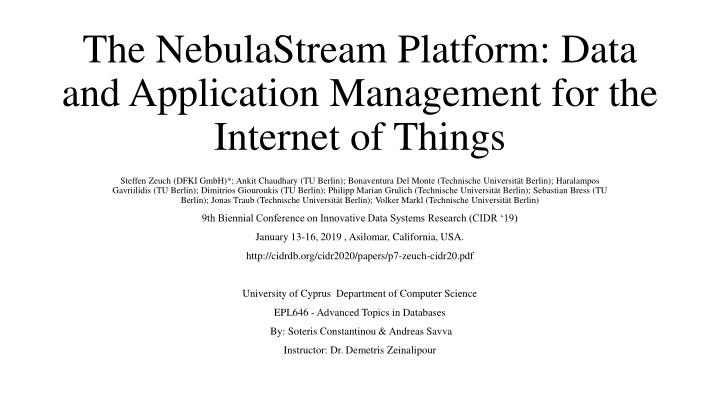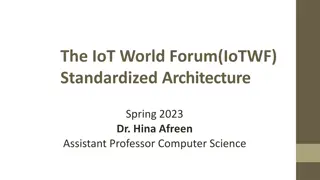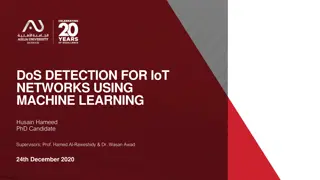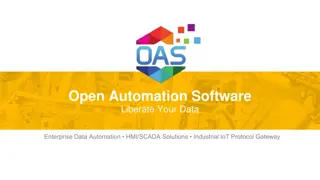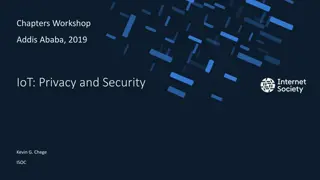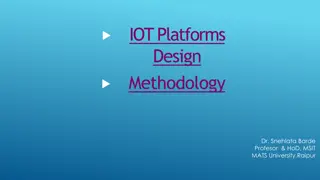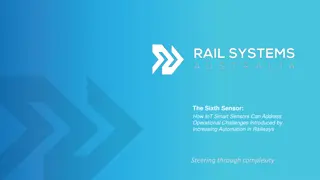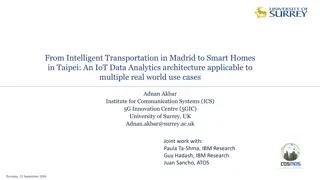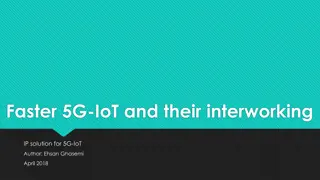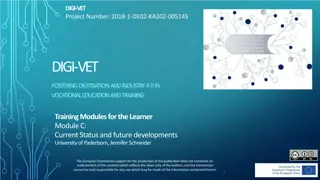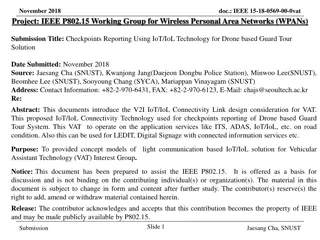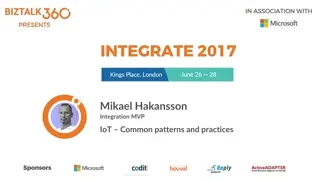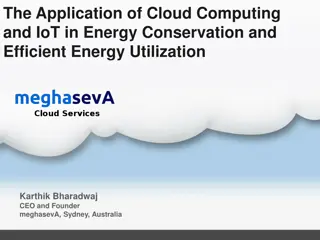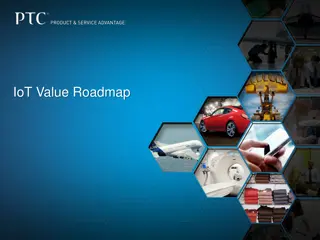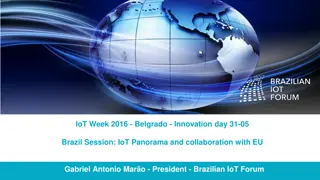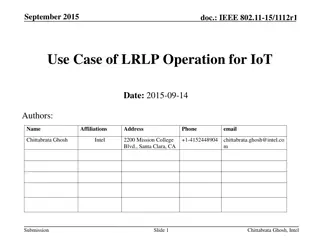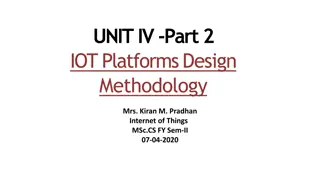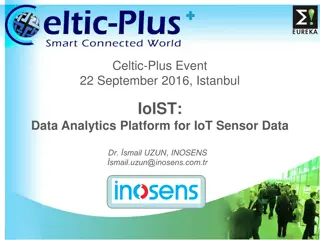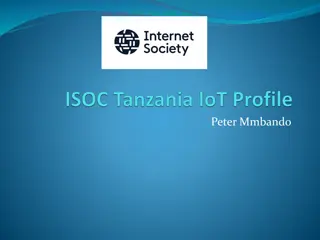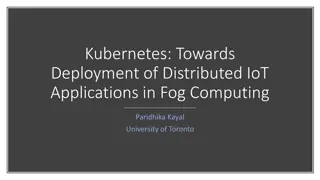The NebulaStream Platform: Data and Application Management for IoT
The NebulaStream Platform addresses challenges in IoT data management, combining cloud, fog, and sensors for efficient processing. It enables low-latency, location awareness, and real-time data processing on distributed sources, overcoming heterogeneity, unreliability, and scalability issues.
Download Presentation

Please find below an Image/Link to download the presentation.
The content on the website is provided AS IS for your information and personal use only. It may not be sold, licensed, or shared on other websites without obtaining consent from the author.If you encounter any issues during the download, it is possible that the publisher has removed the file from their server.
You are allowed to download the files provided on this website for personal or commercial use, subject to the condition that they are used lawfully. All files are the property of their respective owners.
The content on the website is provided AS IS for your information and personal use only. It may not be sold, licensed, or shared on other websites without obtaining consent from the author.
E N D
Presentation Transcript
The NebulaStream Platform: Data and Application Management for the Internet of Things Steffen Zeuch (DFKI GmbH)*; Ankit Chaudhary (TU Berlin); Bonaventura Del Monte (Technische Universit t Berlin); Haralampos Gavriilidis (TU Berlin); Dimitrios Giouroukis (TU Berlin); Philipp Marian Grulich (Technische Universit t Berlin); Sebastian Bress (TU Berlin); Jonas Traub (Technische Universit t Berlin); Volker Markl (Technische Universit t Berlin) 9th Biennial Conference on Innovative Data Systems Research (CIDR 19) January 13-16, 2019 , Asilomar, California, USA. http://cidrdb.org/cidr2020/papers/p7-zeuch-cidr20.pdf University of Cyprus Department of Computer Science EPL646 -Advanced Topics in Databases By: Soteris Constantinou & Andreas Savva Instructor: Dr. Demetris Zeinalipour
Content Introduction Break-down of the problem NebulaStream(NES) IoT application scenario Description of NebulaStream Platform Experimental Demonstration State of the Art Systems Conclusion
INTRODUCTION The International Data Corporation estimated that by 2025 the global amount of data will reach 175ZB 30% of these data will be gathered in real-time 20 billion connected IoT devices by 2025 IoT introduce new challenges for integrating the concepts of fog and cloud computing as well as sensor networks in one unified environment
Break-down of the problem Applications require low-latency, location awareness, widespread geographical distribution, and real-time data processing on potentially millions of distributed data sources Today s data management systems are not yet ready for these applications A centralized cloud approach does not scale for IoT applications To enable future IoT applications, a data management system for the IoT has to combine the cloud, the fog, and the sensors in a single unified platform to leverage their individual advantages and enable cross-paradigm optimizations (e.g., fusing, splitting, or operator reordering). This unified environment imposes three unique characteristics that are not supported by state-of-the-art data management systems: Heterogeneity Unreliability Elasticity
NebulaStream (NES) A novel data processing platform that addresses heterogeneity, unreliability, and scalability challenges Enables effective and efficient data management for the IoT Copes with heterogeneity by maximizing sharing of results and efficiency of computing Addresses unreliability by applying dynamic decisions and incremental optimizations Enables elasticity by designing each node to react autonomously Enables future IoT applications by unifying sensors, fog, and cloud in one general-purpose, end-to-end data management platform Experiments show that NES: Reduces the amount of data and sensor reads up to 90%, increases node throughput and decreases energy consumption on low-end devices Processes queries with low latency even in the presence of many node failures.
IoTAPPLICATION SCENARIO A public transport system of Berlin as a representative IoT scenario Vehicles move around the city and carry a set of sensors and a simple processing unit. Each unit collects vehicle data (e.g., routing, maintenance information, and occupancy/usage) as well as data from the environment (e.g., traffic, road conditions, and weather) Base stations are distributed across the city and consist of antennas, network routers, and compute and storage capacity Processing nodes are distributed within the city to gather data from several base stations and apply more complex processing The centralized dispatch station represents the endpoint for all data and merges data from the fog and the cloud with stored and external data
This IoT scenario requires a massively distributed system with continuous data producers as well as transient and permanent, distributed compute and storage capabilities A fog requires continuous adaptation to a dynamic environment with respect to faults and changes in data and compute nodes. On the sensor level, a system has to continuously adapt the sensor reads depending on a dynamic query workload
NEBULASTREAM PLATFORM NES Topology NES Design Principles NES Architecture NES Solutions for IoT Challenges
NES Topology The figure presents the dataflow from the sensors to the cloud. The basic assumptions in this topology are three-fold. Devices on the path from the sensors to the cloud are able to apply processing. The Cloud Layer is able to apply remaining processing All data might reach the Cloud Layer. NES Topology characteristics: Query optimization finds an efficient route through the Fog Layer that reduces data volumes as early as possible without violating any Service Level-Agreement (SLA) but fulfilling Quality of Service (QoS) constraints It is highly heterogeneous and many nodes have only limited processing capabilities (processing has to trade-off between energy consumption and performance) The Fog Layer is highly unreliable compared to the homogeneous and relatively stable Cloud Layer The volume and velocity of sensor data represent an external factor
NES Design Principles The system design of NES is based on the following design principles: Dynamic Decisions: NES never expects a static behavior or conditions in any component Autonomous Processing: NES equips compute nodes with all logic necessary to act as autonomously as possible Incremental Optimizations: NES optimizes a network of active queries in incremental steps rather than traditional query optimization or batched changes Maximize Sharing: NES shares data and processing wherever possible, i.e., on windows, among queries, on sensor data, and on operator level Maximize Efficiency: NES applies hardware-tailored code generation to exploit the underlying hardware efficiently. SLA Centric Processing: NES s primary goal is to match user-provided SLAs and QoS constraints with available resources Ease of Use: NES enables users to choose their preferred programming environments and models, without worrying about system-internals and performance implications
NES Architecture NES has been designed with a centralized Deployment process and a decentralized run-time re-optimization a logically centralized deployment process in which one central instance has control over the deployment In the current design, users interact with NES through one of the provided APIs to send queries to the NES Coordinator (1) The NES Query Manager is responsible for creating logical query plans from user requests & maintaining logical streams that represent logical views over sensors (2) The NES Topology Manager orchestrates the NES Topology, which consists of workers and sensors The NES Optimizer provides the assignment of a logical query plan to the current NES Topology plan (3) The NES Deployment Manager takes the NES-EP (4), disassembles it into Node Execution Plans, deploys them to the nodes in the NES Topology, into either the Fog or the Cloud Layer, and sets up the sensors (5) The NES Monitor constantly collects feedback from the NES Topology (6) and maintains statistics and current resource utilization for the NES Topology Manager (7).
Volume of Data At-rest and In-Motion In the IoT world, data are generated by many different sources Each source has different characteristics Maximize Sharing principle on three different levels Query Level: Share data among multiple streaming queries Operator Level: Slice data streams to exploit sharing on stream aggregations Sensor Level: Acquisitional Query Processing and On-Demand Schedule of Sensor reads and transmissions This results in a reduction of data that are acquired, transferred and processed
Experimental demonstration Data set: New York taxis Derive routed for every trip Replay the routes on Raspberry Pis This represents the sensor nodes in taxis Baseline: Sensor nodes stream data to cloud NES combines cloud-fog-sensor nodes Allows interleaved data gathering and processing Prevents reads and transmissions for filtered out tuples by the query
Volume of Compute Exploit the hardware resources of heterogeneous devices efficiently Millions of devices in the fog topology NES generates specialized code Depending on query , hardware, data Distributes query optimization Global query optimization splits the query into segments for devices Node engines use query compiler to produce hardware specific code In-network processing to reduce the computation at the Cloud Layer
Testing Using Yahoo Streaming Benchmark on Raspberry Pi 3B+ Python, Flink , Java and NES YSB is a real-world stream processing task Hardware-tailored code generation in essential, especially for low-end devices 80x more energy efficient processing per record vs Python Joining coherent snapshots from 1000 nodes Coherent snapshots: All sensor values have been read at the same time Sensors gather data in pipelines, joining tuples incrementally and coherently Ensures high throughput to the Cloud Layer
Unreliability Transient Failures Heterogeneous fog environment WSNs are prone to failures due to battery powered, low-end devices Cloud Systems use Stop-the-World recovery protocol When an error occurs the entire process stops New query plan is redeployed NES adopts fine-grained recovery Restarts only the operator that caused the failure Dynamic Decisions, Autonomous Processing, Incremental Optimizations Every layer has a different failure recovery approach Sensor: Substitute missing values or broken sensors with nearby sensors or buffered values Fog: Send data to multiple network paths, buffer data and replay them Cloud: Extend existing approaches such as global checkpointing
Ensuring Performance Implement Stop-The-World protocol and Operator Restart on Flink 8 servers Xeon E5620 32GB ram 1Gbits network Compare them in a simulated IoT scenario Randomly terminate compute nodes and measure the latency Latency of the Stop-the-World protocol increases with high transient failures
Diversity in Programming and Management In the IoT world, data must be used by different programming paradigms AI/Machine Learning/Data Science The challenge is not only to support these workloads but also Support optimizable intermediate representations of data Efficient and scalable operators across workloads Combination of Query languages NES will provide an easy to use interface with support for different programming environments No need for programmers to take care of performance implications Nebula-IR is built on top of existing frameworks to support diverse queries and intermediate representation Optimizes Operators and Processing models Allows for Optimization of UDFs in order to achieve high code efficiency Management: Centralized, Homogeneous interface Allows to detect and react to dynamic changes in the environment
Constant Evolution/Changing Environments Fog and WSNs topology constantly changes as new devices join the network and existing devices disconnect Additionally the workloads are constantly evolving as users submit new queries Node-EPs can detect changes to the environment and can react dynamically Reduce the sampling rate, Drop packages, Change algorithm or Reroute data streams Software components allow for changing network topologies and workloads Use of Actor Model Each device is a client, worker or coordinator Allows for devices to be constantly valid states and react autonomously NES can modify an execution plan of a query in steps, in order to have the most optimal plan for changes in the velocity, volume or variety of data Asynchronous process
STATE-OF-THE-ART SYSTEMS Cloud-centric IoT data processing Edge-Aware IoT data processing Fog-aware IoT data processing Data Processing in Sensor Networks
Cloud-centric Approach A pool of sensors sends data directly to the cloud for further processing Camera surveillance Wearable cognitive assistance Smart city Monitoring Advantages: Fault-tolerance, Dynamic scaling of compute and storage resources Disadvantage: Doesn t take advantage of intermediate nodes NES: cross paradigm optimization, in-network processing, hardware tailored code generation
Edge-Aware IoT approach Hub devices placed at the edge of the fog topology in order to act as local control centers Perform simple processing Do not require stable connection the cloud Hub devices still require a stable connection to the sensors and do not address dynamic changes in the topology Existing systems do not offer efficient code computation or a multi- programming environment
Fog-aware IoT data processing NES combine the possible compute and storage capacities of the fog and the cloud Additional research has been conducted on individual challenges in fog computing, which we will leverage in NES Other researchers have proposed the following: Operator placement techniques to partition queries across a fog topology Exploit special capabilities of IoT hardware to improve efficiency and security Solutions to partition the inference of deep neural networks across fog topologies to improve scalability
Data Processing in Sensor Networks Sensor nodes form a network to transfer sensor values through multiple hops to a root node Approaches in this area tackle efficiency by optimizing the computation for battery lifetimes and enable filtering and aggregation queries over sensor data They provide support for a dynamic execution environment In NES, they leverage concepts from sensor networks and integrate them seamlessly across the Sensor, Fog, and Cloud Layers, resulting in a unified environment.
CONCLUSION NebulaStream: a general purpose, end-to-end data management system for the IoT The goal of the envisioned design is to handle the heterogeneity, unreliability, and elasticity of a unified sensor-fog-cloud environment Presented first results that motivate the need of a new system design for upcoming IoT applications NebulaStream Platform, aims to enable emerging IoT applications in different domains
